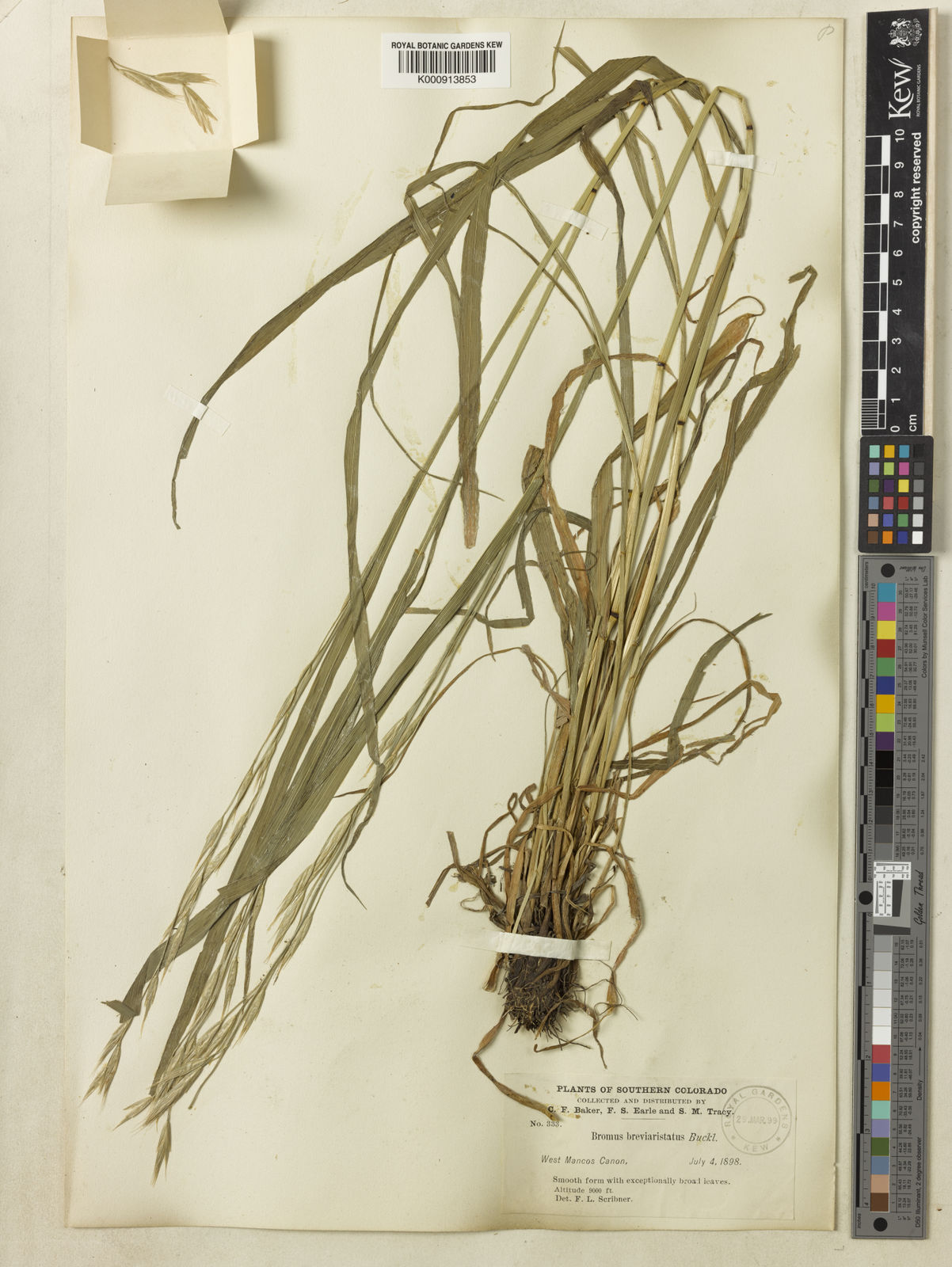Family: Poaceae
Author: Nees ex Steud.
Bibliography: Syn. Pl. Glumac. 1: 322 (1854)
Year: 1854
Status: accepted
Rank: species
Genus: Bromus
Vegetable: False
Observations: W. Canada to C. America
Description
Mountain brome, scientifically known as Bromus marginatus, is a notable species within the Poaceae family. Documented comprehensively since its first scientific description by Nees ex Steud. in the “Synopsis Plantarum Glumacearum” in 1854, this perennial grass has garnered attention for its distinct characteristics and widespread distribution.
Primarily found from Western Canada down through Central America, Mountain brome thrives in a variety of ecological settings. Typically, it occupies areas such as open woodlands, grasslands, and meadows, often favoring nutrient-rich and well-drained soils. Its adaptability to different environments makes it an essential species within its native range, contributing significantly to the biodiversity and stability of these ecosystems.
Characterized by its robust and tufted growth, Bromus marginatus can reach impressive heights, often exceeding three feet under optimal conditions. The plant’s leaves are flat and broad, providing a lush foliage that captures sunlight efficiently, supporting its vigorous growth. Its inflorescence comprises loose, nodding panicles, which bear spikelets that range in color from light green to purplish hues. These spikelets, when mature, release numerous seeds, facilitating the species’ proliferation across its native habitats.
Mountain brome is also valued for its ecological benefits. It serves as an important source of forage for wildlife and livestock, especially in areas where it forms dense stands. Furthermore, its root systems help in preventing soil erosion, stabilizing the ground, and enhancing soil fertility through the recycling of organic matter.
In addition to its ecological importance, Bromus marginatus has been utilized in restoration projects aimed at rehabilitating disturbed lands. Due to its resilience and ability to establish quickly even in degraded soils, it is often employed in reseeding efforts to restore native vegetation and improve habitat quality for local fauna.
Despite its many benefits, Mountain brome can sometimes play the role of an invasive species, outcompeting native plants in certain regions outside its natural distribution. Therefore, management practices are crucial to ensure that its spread does not disrupt local biodiversity.
In summary, Mountain brome (Bromus marginatus) is a vital grass species within the Poaceae family, extending its influence from Western Canada to Central America. Its robust nature, ecological benefits, and role in habitat restoration underline its significance in natural and managed ecosystems.
Common Names
Eng: western brome
En: Mountain brome, Western Brome
Zh: 山地雀麦
Synonyms
- Bromus parviflorus (A.Gray)
- Forasaccus marginatus ((Nees ex Steud.) Lunell)
- Bromus flodmanii (Rydb.)
- Bromus marginatus var. seminudus (Shear)
- Bromus marginatus var. latior (Shear)
- Bromus latior ((Shear) Rydb.)
- Bromus marginatus var. breviaristatus ((Buckley) Beetle)
- Bromus proximus (Shear)
- Ceratochloa marginata ((Nees ex Steud.) W.A.Weber)
- Bromus carinatus var. marginatus ((Nees ex Steud.) Barkworth & Anderton)
- Bromus sitchensis var. marginatus ((Nees ex Steud.) B.Boivin)
- Bromus hookeri var. marginatus ((Nees ex Steud.) E.Fourn.)
Distribution
- Alberta (native)
- Arizona (native)
- British Columbia (native)
- California (native)
- Colorado (native)
- Connecticut (native)
- Costa Rica (native)
- El Salvador (native)
- Guatemala (native)
- Honduras (native)
- Idaho (native)
- Illinois (native)
- Iowa (native)
- Kansas (native)
- Maine (native)
- Masachusettes (native)
- Mexico Central (native)
- Mexico Gulf (native)
- Mexico Northeast (native)
- Mexico Northwest (native)
- Mexico Southeast (native)
- Mexico Southwest (native)
- Montana (native)
- Nebraska (native)
- Nevada (native)
- New Hampshire (native)
- New Mexico (native)
- New York (native)
- Oregon (native)
- Saskatchewan (native)
- South Dakota (native)
- Utah (native)
- Washington (native)
- Wyoming (native)
- Alaska (introduced)
- China North-Central (introduced)
- Czechoslovakia (introduced)
Additional Images
Habit
Taken Jan 16, 2015 by EOL − podiceps (cc-by-nc)

© copyright of the Board of Trustees of the Royal Botanic Gardens, Kew.
Sources
- WFO (No URL)
- IPNI (No URL)
- GBIF (https://www.gbif.org/species/2703686)
- POWO (http://powo.science.kew.org/taxon/urn:lsid:ipni.org:names:37093-2)
- PlantNet (https://identify.plantnet.org/species/the-plant-list/Bromus marginatus Nees ex Steud.)
Specifications
Growth form>: Bunch
Growth habit>: Graminoid
Growth rate>: Rapid
Growth
Ph maximum: 8.0
Ph minimum: 5.5

